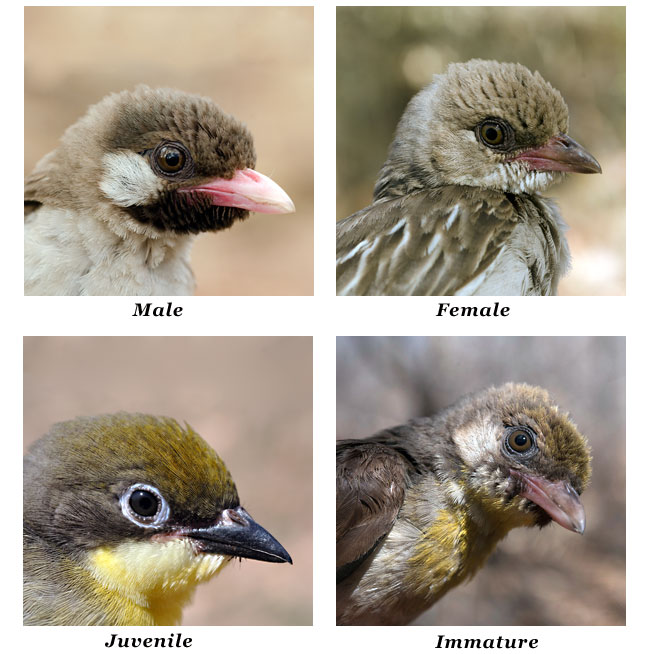About honeyguides
How does the honeyguide-human relationship work?
The relationship between Greater Honeyguides and people is a mutualism, which means that it benefits both partners. Honeyguides eat beeswax and know where bees’ nests are located, but can’t get at what’s inside. Humans want to eat or sell honey and are less good at finding bees’ nests, but know how to subdue the bees and get at their nest. So honeyguides guide people to wild bees’ nests, using special calls and behaviour, and wait for their human collaborator to smoke out the bees and chop open their nest. By working together, the two species can thus expose the beeswax for the honeyguides, and honey for the humans. This remarkable cooperation with honeyguides is deeply embedded in many African cultures, and may be hundreds of thousands of years old. We are interested to find out where in Africa this remarkable mutualism between birds and humans still occurs. So this why you can help us! You can help us by submitting your sighting of a Greater Honeyguide from anywhere Africa, and tell us whether it tried to guide you! For more information see About the project.
How to tell an adult from an immature honeyguide

Adult male Greater Honeyguides (top left) are brown all over except for a blackish throat and top of head, and have a bright pink bill. Adult female Greater Honeyguides (top right) are brown all over with no special head markings, and have a dull, darkish bill. Juvenile Greater Honeyguides of both sexes (bottom left) are bright lemon-yellow below, olive-green above, a black bill and pale rumps. In immature Greater Honeyguides (bottom right), the yellow on the throat is patchy. Greater Honeyguides of all ages have white outer tail feathers. It’s usually easy to tell in the field whether a Greater Honeyguides is an adult or a juvenile/immature, but you might need a good look through binoculars to confirm whether an adult bird is a male or female.
How do I know when a honeyguide is guiding me?
When a Greater Honeyguide wants to guide you, it will alert you to its presence with a distinctive, nasal chattering call –“tjrrr tjrrr tjrrr tjrrr”– listen to it here:
This guiding call is given by both males and females, and both adults and juveniles, and sounds completely different from the males’ territorial “vic-torrr” call:
Often it will be hard to see the bird, sometimes concealed behind leaves high in the trees. If you approach it, it will probably fly to another tree in the direction of a bees’ nest; you may catch a glimpse of its conspicuous white outer tail feathers as it flies. Note that the Greater Honeyguide is the only species of honeyguide that is known to guide humans.
What should I do if a honeyguide guides me?
If you like, you can follow it – walk from tree to tree following the bird’s call. If it seems to disappear, don’t despair; it will be probably be back within a few minutes, chattering somewhere ahead of you. The bees’ nest can be anything from right next to the bird when it first calls, to a kilometre or more away. When the honeyguide is very near to the nest (in the same tree or in an adjacent tree), it will usually stop and fall quiet, sometimes just giving an occasional quiet chatter. That’s the time to pause and carefully scan the branches above. Usually the nest will be well concealed in a natural tree cavity, revealed only by the occasional bee flying in or out of it, but sometimes the honeycombs hang free under a large branch or against a broken-off stump. More rarely it will be in a cavity in the ground, such as a termite mound or rock hollow. If you find a bees’ nest with the help of a honeyguide, please make a note of the location and tree species if you know it, or take a photograph – we’ll be very interested to know any further details about your sighting.
Do honeyguides ever guide people to anything other than honeybees?
Yes! Honeyguides usually guide people to honeybees (Apis mellifera), but sometimes they guide people to other kinds of bees, specifically the various stingless bee species (meliponines, such as the sweatbees) which also produce wax and honey in smaller quantities. Stingless bee nests are a bit harder to spot, but are revealed by the occasional tiny bee entering or exiting a small yellow wax “trumpet” emerging from the tree bark. Many people say that honeyguides also sometimes guide them to other interesting things in the bush, such as snakes, buffaloes, or dead elephants. We don’t know yet whether this is accidental or intentional on the part of the honeyguide, but would be very interested to hear your experiences.
How to tell a honeybee from a stingless bee

Honeybee (Apis mellifera) nests can either be concealed within tree cavities (left), or with the combs hanging exposed on the outside of a large tree such as a baobab (centre). Stingless bees (meliponines such as the Trigona sweatbees) are much smaller than honeybees – only a few millimetres long. Their nests are concealed within a small cavity in a tree and quite hard to spot, but the nest entrance is betrayed by a little “trumpet” made of wax (right), about a centimetre wide.
What about brood parasitism by honeyguides?
Another fascinating aspect of honeyguides’ lives! For more information about the darker side of the Greater Honeyguide, please visit www.AfricanCuckoos.com which describes our research on their cuckoo-like breeding behaviour. One intriguing consequence of this parasitic lifestyle is that young honeyguides are unlikely to learn the guiding behaviour from their own parents.







 The FitzPatrick Institute of African Ornithology seeks "To promote and undertake scientific studies involving birds, and contribute to the practice affecting the maintenance of biological diversity and the sustained use of biological resources."
The FitzPatrick Institute of African Ornithology seeks "To promote and undertake scientific studies involving birds, and contribute to the practice affecting the maintenance of biological diversity and the sustained use of biological resources." The University of Cape Town is known for its academic excellence and pioneering scholarship. Through a culture of teaching and learning, UCT strives to turn out graduates who are engaged citizens, able and willing to apply their expertise across the African continent.
The University of Cape Town is known for its academic excellence and pioneering scholarship. Through a culture of teaching and learning, UCT strives to turn out graduates who are engaged citizens, able and willing to apply their expertise across the African continent.